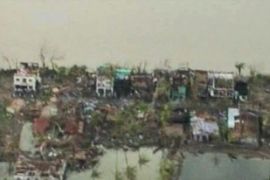Myanmar cyclone kills 10,000 people
Government asks for foreign aid as thousands of people remain missing.

Nyan Win, the foreign minister, told state television on Monday: “According to the latest information, more than 10,000 people were killed.
| IN VIDEO |
The UN office for the Co-ordination of Humanitarian Affairs (UNOCHA) said that the government – which has indicated it will press ahead with its referendum on a new constitution on Saturday – was “having as much trouble as anyone else in getting a full overview” of the destruction.
 |
| Locals and the military have begun the clean up in Yangon [AFP] |
Terje Skavdal, the regional head of UNOCHA, said: “Roads are not accessible and many small villages were hit and will take time to reach.”
Teams of foreign aid workers were trying to assess the damage and aid needs, but their access and movements are restricted by the military.
“That is the existing situation for international staff. The way most agencies work is they use national staff who have more freedom to move,” Skavdal said.
“We will have a dialogue with the government to try to get access to the people affected.”
James East, of the aid agency World Vision who has nearly 500 staff in the country, told Al Jazeera: “Our staff met with some of the government from the ministry of social welfare yesterday and they told us about the eight townships that have been most impacted by Cyclone Nargis.
“They said that 90 to 95 per cent of the homes in those townships have been severely damaged.
“When we added up the numbers that comes to somewhere in the region of two million people.”
‘Dire situation’
Al Jazeera’s correspondent, who cannot be named for security reasons, in the costal town of Yangon said that the clean up operation in the former capital appeared to be going quite well.
“Electricity and water lines are down, but the military and police are on the ground clearing trees off the road and getting water supplies to people.
“However, several hours from here in the Irrawaddy Delta, which is a huge area, the situation is dire.
“The extent of the destruction is getting worse by the hour. This morning [Monday] the official word from the government was that the 351 people had died. In the last 12 hours that has jumped to 10,000.
“There are 4,000 people presumed missing in this region.”
Aid groups’ plea
The Forum for Democracy in Burma and other dissident groups outside
Myanmar, formerly known as Burma, have also urged the military government to allow aid groups better access.
 |
| Groups are concerned the government wil not be able to cope with the disaster [EPA] |
Naing Aung, secretary-general of the Thailand-based group, said: “International expertise in dealing with natural disasters is urgently required.
“The military regime is ill-prepared to deal with the aftermath of the cyclone.”
The government has declared Yangon, the Irrawaddy Delta, and the south-eastern states of Bago, Karen and Mon as disaster areas.
State-controlled television reported that 20,000 homes had been destroyed on Haingyi, an island in the Andaman sea.
A further 90,000 people on the island, the first part of the country to be hit by the cyclone, were left homeless, the government said.
‘Flattened’
Chris Kaye, the UN’s acting humanitarian co-ordinator in Yangon, confirmed that “the Irrawaddy delta was hit extremely hard not only because of the wind and rain but because of the storm surge”.
“The villages there have reportedly been completely flattened.”
It is unknown to what extent the destruction caused by the cyclone will affect the holding of a referendum on May 10, on a new charter backed by the ruling generals.
But the government indicated that it would proceed as planned.
“It’s only a few days left before the coming referendum and people are eager to cast their vote,” the state-owned newspaper Myanma Ahlin said on Monday.
The military says the vote is the first stage in a seven-step “road map to democracy”, intended to culminate in multi-party elections in 2010.
The process has been criticised by opposition groups which say the process is intended only to tighten the military’s grip on power.
